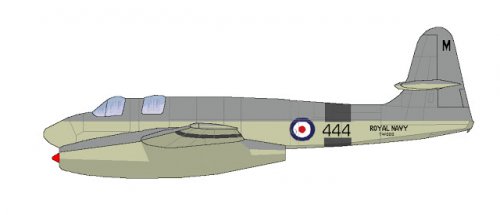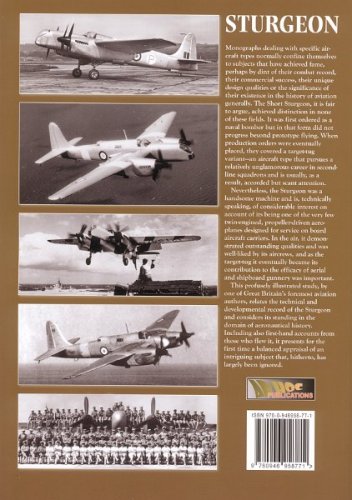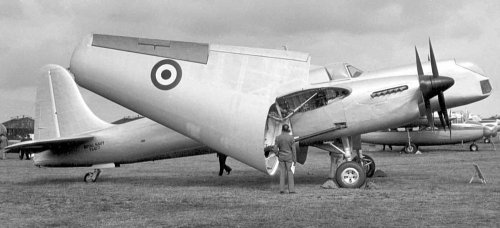blackkite
Don't laugh, don't cry, don't even curse, but.....
- Joined
- 31 May 2007
- Messages
- 8,489
- Reaction score
- 6,582
Hi!
http://www.oocities.org/heartland/village/4082/brit/odd_air.htm
"Specification S.11/43 was for a naval reconnaissance aircraft. The specification called for the design and construction of a twin-engine reconnaissance aircraft for visual and photographic reconnaissance and shadowing, by day or night. The aircraft was to have a maximum all up weight of 24,000 lb. Height (stowed) 17 ft., 1ength 45 ft., Span (spread) 60 ft., Span (folded) 20 ft. Power wing folding was also required.The contract to produce the aircraft to this specification went to Short Bros for their S38 Sturgeon.
A contract was issued on 12/2/44 for 3 prototypes, with serials RK787, RK791 & RK794. The first Short SA.I Sturgeon I RK787 flew at Rochester Airport on 7/6/46. The second, RK791, flew from Sydenham on 18/5/48, A third, RK794, was modified to a Mk.2 with a new serial, VR363.
Other manufacturers in contention were Armstrong Whitworth with its Armstrong Whitworth A.W.54 and A.W 54A(jet aircraft), Westland with design studies utilising either H. I turbojet or Pratt and Whitney radial engines, and an unnumbered Supermarine project."
Tony-san's great book include Blackburn S.11/43 and Fairey S.11/43.
Sturgeon.
https://en.wikipedia.org/wiki/Short_Sturgeon
"Variants
Sturgeon S.1Carrier-borne strike aircraft, one completed at Shorts, Rochester before production moved to Belfast. Three prototypes were ordered but the third was completed as the TT.2 prototype. The production contract for 30 S.1s to build at Rochester was cancelled.
Sturgeon TT.2target tugs, two prototypes and 23 production aircraft ordered to be built at Belfast some later converted to the TT.3 standard.
Sturgeon TT.3 Revised target tug variant, five modified at Rochester from TT.2s.
S.B.3Prototype anti-submarine aircraft built in Belfast. Two prototypes ordered with the first flying on 12 August 1950 and then demonstrated at the 1950 Society of British Aerospace Companies' (SBAC) Farnborough Airshow; the second example was completed but never flown.
Jet Sturgeon Night fighter Drawings exist for a Sturgeon variant modified with two Rolls Royce AJ.40 turbofans in place of the Merlins and armed with four 20mm Hispano cannon. This was linked to the 1945 decision by the Assistant Chief of the Naval Staff (Air) to order the evaluation of a Sturgeon night fighter derivative with improved performance as a low-risk alternative to the development of the De Havilland Sea Hornet NF.21 under N.21/45. As the Sea Hornet NF.21 was successful, no detailed development followed.
Operators"
Flightglobal Sturgeon.
https://www.flightglobal.com/pdfarchive/view/1946/1946%20-%202080.html
Jet Sturgeon picture is here.
http://beyondthesprues.com/Forum/index.php?PHPSESSID=ftu9de3o40fp2shen3b9eabm85&topic=1428.0
SB.3 pictures.
http://www.airwar.ru/enc/sea/sb3.html
Prototype pictures.
https://forum.keypublishing.com/showthread.php?122135-Short-Sturgeon-First-and-second-Prototype
TT.2 picture. Nose shape is interesting.
https://elpoderdelasgalaxias.wordpress.com/2016/10/20/short-sturgeon-tt-2-swords-into-punching-balls/
TT.3 picture.
http://www.hyperscale.com/2009/reviews/books/sturgeonbookreviewsn_1.htm
http://www.oocities.org/heartland/village/4082/brit/odd_air.htm
"Specification S.11/43 was for a naval reconnaissance aircraft. The specification called for the design and construction of a twin-engine reconnaissance aircraft for visual and photographic reconnaissance and shadowing, by day or night. The aircraft was to have a maximum all up weight of 24,000 lb. Height (stowed) 17 ft., 1ength 45 ft., Span (spread) 60 ft., Span (folded) 20 ft. Power wing folding was also required.The contract to produce the aircraft to this specification went to Short Bros for their S38 Sturgeon.
A contract was issued on 12/2/44 for 3 prototypes, with serials RK787, RK791 & RK794. The first Short SA.I Sturgeon I RK787 flew at Rochester Airport on 7/6/46. The second, RK791, flew from Sydenham on 18/5/48, A third, RK794, was modified to a Mk.2 with a new serial, VR363.
Other manufacturers in contention were Armstrong Whitworth with its Armstrong Whitworth A.W.54 and A.W 54A(jet aircraft), Westland with design studies utilising either H. I turbojet or Pratt and Whitney radial engines, and an unnumbered Supermarine project."
Tony-san's great book include Blackburn S.11/43 and Fairey S.11/43.
Sturgeon.
https://en.wikipedia.org/wiki/Short_Sturgeon
"Variants
Sturgeon S.1Carrier-borne strike aircraft, one completed at Shorts, Rochester before production moved to Belfast. Three prototypes were ordered but the third was completed as the TT.2 prototype. The production contract for 30 S.1s to build at Rochester was cancelled.
Sturgeon TT.2target tugs, two prototypes and 23 production aircraft ordered to be built at Belfast some later converted to the TT.3 standard.
Sturgeon TT.3 Revised target tug variant, five modified at Rochester from TT.2s.
S.B.3Prototype anti-submarine aircraft built in Belfast. Two prototypes ordered with the first flying on 12 August 1950 and then demonstrated at the 1950 Society of British Aerospace Companies' (SBAC) Farnborough Airshow; the second example was completed but never flown.
Jet Sturgeon Night fighter Drawings exist for a Sturgeon variant modified with two Rolls Royce AJ.40 turbofans in place of the Merlins and armed with four 20mm Hispano cannon. This was linked to the 1945 decision by the Assistant Chief of the Naval Staff (Air) to order the evaluation of a Sturgeon night fighter derivative with improved performance as a low-risk alternative to the development of the De Havilland Sea Hornet NF.21 under N.21/45. As the Sea Hornet NF.21 was successful, no detailed development followed.
Operators"
Flightglobal Sturgeon.
https://www.flightglobal.com/pdfarchive/view/1946/1946%20-%202080.html
Jet Sturgeon picture is here.
http://beyondthesprues.com/Forum/index.php?PHPSESSID=ftu9de3o40fp2shen3b9eabm85&topic=1428.0
SB.3 pictures.
http://www.airwar.ru/enc/sea/sb3.html
Prototype pictures.
https://forum.keypublishing.com/showthread.php?122135-Short-Sturgeon-First-and-second-Prototype
TT.2 picture. Nose shape is interesting.
https://elpoderdelasgalaxias.wordpress.com/2016/10/20/short-sturgeon-tt-2-swords-into-punching-balls/
TT.3 picture.
http://www.hyperscale.com/2009/reviews/books/sturgeonbookreviewsn_1.htm
Attachments
-
 Short stUrgeon.jpg34.6 KB · Views: 634
Short stUrgeon.jpg34.6 KB · Views: 634 -
 Short Jet-Sturgeon Nightfighter Base Top.jpg26.6 KB · Views: 190
Short Jet-Sturgeon Nightfighter Base Top.jpg26.6 KB · Views: 190 -
 Short Jet-Sturgeon NF Side Base.jpg21.5 KB · Views: 161
Short Jet-Sturgeon NF Side Base.jpg21.5 KB · Views: 161 -
 AW54A.jpg15.7 KB · Views: 178
AW54A.jpg15.7 KB · Views: 178 -
 e0e26c1360ba98da2eb4c03ef0eb633b--shorts-google-search.jpg66.1 KB · Views: 187
e0e26c1360ba98da2eb4c03ef0eb633b--shorts-google-search.jpg66.1 KB · Views: 187 -
 Sturgeon_AdHoc_Rearcover_01_fs.jpg71.4 KB · Views: 162
Sturgeon_AdHoc_Rearcover_01_fs.jpg71.4 KB · Views: 162 -
 perhaps Sturgeon TT.3.jpg26.7 KB · Views: 519
perhaps Sturgeon TT.3.jpg26.7 KB · Views: 519 -
 short_sturgeon.gif27.1 KB · Views: 553
short_sturgeon.gif27.1 KB · Views: 553 -
 Sturgeon TT.2.jpg70.4 KB · Views: 541
Sturgeon TT.2.jpg70.4 KB · Views: 541 -
 Sturgeon second prototype.jpg109.8 KB · Views: 581
Sturgeon second prototype.jpg109.8 KB · Views: 581





